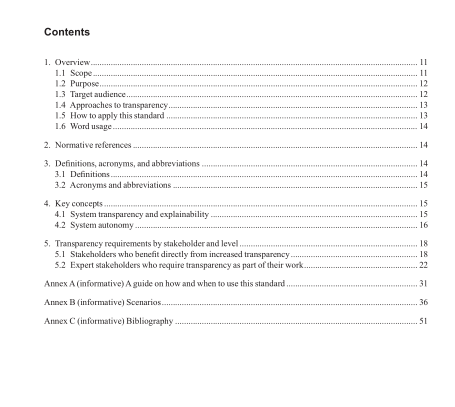IEEE 7001-2021 pdf download.IEEE Standard for Transparency of Autonomous Systems
1.4 Approaches to transparency
Broadly, transparency requires three parallel approaches, as follows:
— The frst is process standards for ethically aligned design; that is, standards setting out human processes for ethically designing, validating, and operating robotics and AI systems. The IEEE Standards Association working groups are currently drafting a series of so-called human standards. The frst of these, IEEE Std 7000™-2021, [B25], is a model process for addressing ethical concerns during system design.
— Second, a standard is needed for transparency; IEEE Std 7001-2021 is that standard.
— Third, technologies for transparency are needed. This standard does not specify technologies to support transparency, although for one stakeholder group, incident/accident investigators, this standard requires data logging to be incorporated into autonomous systems.
Data logging is required to provide investigators with time stamped records of what a system was doing prior to and during an incident. The technical specifcation of such data logging systems is outside the scope of this standard. Transparency has widespread economic and social benefts, such as greater social trust. Greater transparency eases coordination through sharing of information such as plans, intentions, and status. Transparency can inform consumer choice, thereby rewarding quality and excellence, and encourages less scrupulous actors to change their behavior. Transparency also allows incentives to be aligned more easily. For example, insurers may be able to offer a more accurate premium if they better understand the characteristics of an autonomous system in its operation and not merely after an incident. However, transparency should be designed into the system; ideally from its inception rather than retroactively. The quality of transparency does not manifest without careful consideration and adherence to best practices and rigorous standards.
1.5 How to apply this standard There are two ways in which this standard can be applied in practice, as follows:
— A System Transparency Assessment (STA) is the process of evaluating the transparency of an existing autonomous system, for each stakeholder group.
A system is conformant with IEEE Std 7001-2021 if the STA determines that it meets at least Transparency Level 1 in at least one declared stakeholder group. Such minimal conformance may not be acceptable to the stakeholders of the system in question. Determination of what are appropriate or minimum acceptable levels of transparency for a given system is made by writing a System Transparency Specifcation (STS), as defned in the next list item. Direct comparison of transparency requirements in the STS with measured transparency in the STA can help reveal transparency gaps that need to be addressed.
Information that improves transparency shall also be provided in an accessible format that supports comprehension by stakeholders.
— An STS is the process of defning the transparency requirements of an autonomous system, for each stakeholder group. An STS may be written at any time during a system’s lifecycle, though the best and expected practice would be to specify transparency requirements prior to system design (see IEEE/ ISO/IEC Std 15288:2015 [B26] and IEEE/ISO/IEC Std 12207:2017 [B30]).
It is important to note that transparency requirements will vary considerably from one system to another. A prerequisite of writing an STS is to decide on the appropriate level of transparency for each stakeholder group and for the system under consideration.
Detailed guidelines on how and when to apply this standard, with templates for the processes of STA and STS, are given in Annex A. This standard does not prescribe minimum acceptable levels of transparency for particular autonomous systems (or categories of systems), however, detailed worked examples of STA and STS are given in a set of scenarios, for both fctional and (some) real autonomous systems, in Annex B.
1.6 Word usage
The word shall indicates mandatory requirements strictly to be followed in order to conform to the standard and from which no deviation is permitted (shall equals is required to). IEEE 7001 pdf download.IEEE 7001-2021 pdf download
IEEE 7001-2021 pdf download

Leave a Reply